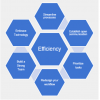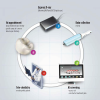You must be signed in to read the rest of this article.
Registration on CDEWorld is free. Sign up today!
Forgot your password? Click Here!
"Respond, recover, and thrive" are three terms that resilient organizations emphasize when faced with a crisis.1 In a 2020 Deloitte survey of CEOs, maintaining employee well-being, sustaining innovation, addressing declining revenues, and engaging customers were among the top concerns during the pressures of the pandemic.2 The common thread among the responses was the "ever-accelerating pace of change." In 2020, innovation and technology converged to meet the demands necessary to navigate a global pandemic. Advancements in digitization, organizational leadership, and data management enabled some entities to keep pace and thrive.
For example, prior to the onslaught of COVID-19, widespread adoption of the electronic medical or health record had been challenging, despite the fact that the electronic medical record (EMR) was an advancement over the inefficiencies inherent with paper charting.3,4 These data are used to determine diagnosis and treatment, track outcomes. and assess risks. Digitization improves transparency with providers, patients, and payors, alleviating inefficiencies within the health care system. In addition, taking routine and non-essential tasks out of the process helps free up time to rebuild the doctor-patient relationship.
COVID-19 has propelled health care into a future wherein digital connections have achieved new levels of acceptance, paving the way for tele-dentistry/tele-medicine efficiencies for practices and patients.5 Patients are often more willing to accept these digital efficiencies and changes than practitioners expect. In some cases, practitioners are more willing to accept changes as individuals than they are to implement them into their patient workflow. Digitalization processes, including IoT, real time data processing, AI, ML, quantum computing, and neural links, will significantly impact the way people live and work. Given that most people look for convenience and simplicity in their daily lives, practitioners should carefully evaluate their traditional ideas on touch points and methods to build patient relationships, trust, acceptance of care, and confidence. This is an opportunity to stop resisting change. Evaluate whether willingness (or lack thereof) to adapt and change is based on personal bias, noise, comfort, and routine, rather than patient expectations. The ability to adapt, evaluate, and assess the risks and benefits of digitized processes and not simply reject these technologies out of hand will be essential for dental practices in determining the path forward. The digital dental coordinator may become a new role in oral healthcare, joining the implant coordinator and the practice relations coordinator.
Real-time navigation and analysis of the COVID-19 pandemic has been stressful for all sectors of health care. Many factors are still unresolved, such as access to accurate, inexpensive, and accessible testing; contact tracing; N95 mask availability; fit testing; an impending global glove shortage; virus resurgence; virus mutation; vaccination; and the effect of increasing digitization and remoteness of work.5-7 The way clinicians react and respond to the ongoing uncertainty will impact their practices and lives, along with family, friends and coworkers. Developing a strategic plan to address these and other scenarios could be not only quite beneficial, but also critical.
Determining Digital Priorities
Consider the efficiencies inherent in a digitized workflow. Digitization has transformed many aspects of people's lives, trading repetitive, low-value human tasks for efficient automation and immediacy, resulting in the freedom to participate in higher value interactions. Consequently, digital adoption and automation are directly proportional to increased provider-patient engagement. These transformative changes include shifts from paper charts to EMRs; from telephone to text, email, and tele-dentistry; from analog radiographs to digital; from alginate dental impressions to STL optical capture; from analog to digital crown-and-bridge workflows; and from surveyor/drill press for implants to planning software and 3D printers. While not always easy to integrate, these systems have enabled enhanced accuracy and efficiencies that are invaluable to a practice and its patients. In general, dentistry has embraced digital change on many levels.
While currently navigating the impact of tele-dentistry on practices, the dental industry is in flux. Digital platform webinars and meetings have allowed for unprecedented global collaboration, personally and professionally. At the same time, digital platforms of communication thrust upon clinicians due to COVID-19 have become more user-friendly, allowing dental teams to incorporate aspects of tele-dentistry into their routines with less friction.5,8
Digital is not a technology-it is a strategy.9 Digitization provides opportunities for real-time customized experiences and predictive insights at unparalleled speeds11 Although digital processes require a learning curve for full integration, operating costs subsequently should drop due to efficiencies. However, before a practice can consider adopting digital, practitioners should consider how to create an acceptance culture internally to enable its success. There should be a sense of urgency and a clear vision of what the practice would like to achieve. This vision must be communicated effectively and the action to implement empowered to the team (a summary of the process and steps that can be used to facilitate change is illustrated in Figure 1).9
Tele-dentistry is a platform for change. Dentists have an opportunity to decide the extent, if any, to incorporate this technology into their practice and its impact on patient flow. Understanding the differences between platforms and methods of digital communication will help determine which strategy is right for them and their team.
Digital Communication and Processes:
∙ Communication types:
○ asynchronous
○ synchronous
○ nomadic
○ practice based digital communication
∙Processes:
○ PMS
○ impressions
○ laboratory
○ supplies
○ billing
○ insurance claims
○ dashboard analytics
Nomadic communication builds awareness, but is not linked directly to a dental provider. An office-based system is linked to a specific dental office or group of offices. While some forms of digital communication help prevent hospital emergency department visits, others help streamline routine dental care. There is a wide and growing range of options to choose from in implementing this technology into practice workflow.
The holodeck from Star Trek may become reality one day and allow people to transform their homes into a digitalized health facility, providing real time interactions, data capturing, and analysis, along with testing, diagnosis, and treatment options. This may include virtual avatar screenings and human interaction with providers. Adoption of tele dentistry today could be the first step towards a digital home health room and perhaps a universal electronic medical/dental record optimizing patient health and wellness. An integrated future is dependent upon interoperability and seamless data transfer leading to enhanced care and improved outcomes.10
The Impact on Patient Care
In 2020, the ADA updated its policy on tele-dentistry, originally created in 2015.12 The codes for synchronous and asynchronous consultations (D9995 and D9996, respectively) are available to be utilized. The most significant impact of the emerging virtual workflow appears to be on visit efficiency and streamlining care. Some providers are segmenting patient appointments into data collection and case presentation. For example, express X-rays and intraoral digital scans are components of data collection, resulting in time savings and the ability to review and develop a treatment plan prior to consulting with the patient. In many instances, the hygienist or dental assistant can help to triage patients for their consult and discussion with the provider. As tele-dentistry progresses, digital consent forms and other seamless links into various practice management systems are incorporated to record and document the discussion. Scheduling can be done digitally through the practice web site as well. Most importantly, speaking to patients at a convenient time while they are not in the operatory means one less step in the patient journey for care delivery. Not all patients will adapt initially. Some patients will still visit in person based on their needs, while others are unable to manage the complexities of a digital visit. Therefore practices must be flexible and open to helping patients prepare for their visits, whether they be digital, in-person, or a combination (Figure 2).
Digitization can also expand the scope of dental practice. A trend within the dental profession has been a heightened awareness of the significance of artificial intelligence and machine learning, along with a recognition of oral-systemic health links. Taking routine and nonessential tasks out of the process could help free up time for the doctor-patient relationship to be rebuilt. Artificial intelligence (AI) and machine learning (ML) may be the vector through which people navigate these challenges.
Aggregation and smart processing of cloud-based data can lead to efficient and accurate diagnosis, treatment, outcome tracking, and the development of predictive analytics, as well as individual patient phenotypic risk assessment scores. Digitalization can lead to transformative change in the accuracy and speed at which universal knowledge is mobilized to improve population health and wellness. The drive toward digitalization has also made way for analog communication. If used properly, advancements in technological innovation may free time to create more meaningful "analog" interactions with patients.
Hard evidence collected through advancing digital data linking oral health to systemic health could be significant in elevating the position of oral healthcare providers in overall healthcare and wellness, repositioning the role of these professionals to impact systemic and population health.
Although the effects of COVID-19 have presented major challenges worldwide, this period has also brought health care practitioners together, sharing ideas and solving problems. Being a central part of this transition means that clinicians have a responsibility to adapt for the sake of their patients. Ask hard questions, be critical, and use evidence-based decisions to help shape the future of patient care. Dentistry can be on the forefront of reinvention for a better future, as demonstrated by this profession throughout history.
About the Author
L. Eric Pulver, DDS, FRCD (C)
Private practice, Highland, Indiana
References
1. Linthicum D. Respond, recover, and thrive. Deloitte web site. June 26, 2020. https://www2.deloitte.com/us/en/pages/consulting/articles/respond-recover-and-thrive.html. Accessed March 2, 2021.
2.Fortune/Deloitte CEO Survey. Deloitte Development. October 2020. https://www2.deloitte.com/content/dam/Deloitte/us/Documents/CMO/fortune-deloitte-CEO-survey-october-2020-highlights.pdf. Accessed March 2,2021.
3.Bailey JE. Does health information technology dehumanize health care?Virtual Mentor.2011;13(3):181-185.
4. Schilling B. The federal government has put billions into promoting electronic health record use: how is it going? The Commonwealth Fund web site. https://www.commonwealthfund.org/publications/newsletter-article/federal-government-has-put-billions-promoting-electronic-health. Accessed March 2, 2021.
5. McLeod C, Apostolon D, Tranby EP, Mathews R. Provider Teledentistry Use Gains Traction During COVID-19. November 2020. DentaQuest Partnership for Oral Health Advancement. Boston, MA. DOI: 10.35565/DQP.2020.2020.
6. Resnick B, Irfan U. The new UK coronavirus mutations, explained. Vox. December 30, 2020. https://www.vox.com/science-and-health/22192061/mutant-coronavirus-covid-19-uk-mutation-vaccine. Accessed March 2, 2021.
7. Iyengar R. If you want to travel next year, you may need a vaccine passport. CNN Business. December 28, 2020.https://www.cnn.com/2020/12/27/tech/coronavirus-vaccine-passport-apps/index.html. Accessed March 2, 2021.
8 . Kappe B, Horton R. COVID-19 and "The Great Acceleration of Digital Health." Orthogonal web site. June 5, 2020.https://orthogonal.io/insights/covid-19-and-the-great-acceleration-of-digital-health/. Accessed March 2, 2021.
9. Future of global business services.Deloitte web site.https://www2.deloitte.com/us/en/pages/operations/articles/global-business-services-digital-transformation.html. Accessed March 2, 2021.
10. Joda T, Waltimo T, Probst Hensch N. Public Health Genomics. 2019;22(1-2):1-7.
11. Hullinger R, Markovitz S. Transforming homes and communities into healthcare hubs in the post-Covid future. Forbes. October 26, 2020. https://www.forbes.com/sites/coronavirusfrontlines/2020/10/26/transforming-homes-and-communities-into-healthcare-hubs-in-the-post-covid-future/. Accessed March 2, 2021.
12. Garvin J.ADA updates teledentistry policy. ADA News. November 5, 2020. https://www.ada.org/en/publications/ada-news/2020-archive/november/ada-updates-teledentistry-policy. Accessed March 2, 2021.



